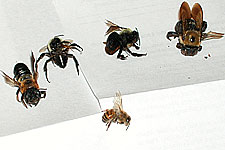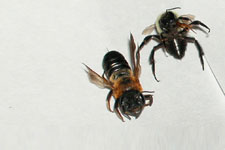 Sometimes, when completing the morning rounds of watering plants and watching the bees wake up, I find dead non-honeybees around the colonies, especially near Twain. Since Queen Ellie is such a potent potentate, and the Bee Cool units (used to help ventilate the hives when temperatures are high) vent so much of the internal air with her pheromone in it, they mostly collect around her domain. For some reason, it was very hard to get a good picture of my new collection of dead bees. My hubby took these for me.
Sometimes, when completing the morning rounds of watering plants and watching the bees wake up, I find dead non-honeybees around the colonies, especially near Twain. Since Queen Ellie is such a potent potentate, and the Bee Cool units (used to help ventilate the hives when temperatures are high) vent so much of the internal air with her pheromone in it, they mostly collect around her domain. For some reason, it was very hard to get a good picture of my new collection of dead bees. My hubby took these for me. Mostly, my patient friends react to my new bug-eyed fascination by nodding, and taking a couple of steps back when I stick what looks like a pile o'bees under their noses. But maybe this photo can help explain the differences I am seeing, and the questions they bring to mind.
First, the bee at the lower right is a honeybee, slightly smaller than in life because she dried out a bit. Above her, from right to left, are a Carpenter Bee, and then two true bumblebees who seem to belong to the same species. Finally, at left, is an enormous Mystery Bee that literally stopped me in my tracks. As much as my mind has been changing on the subject of insects, the latter reaction was straight from the flight-or-fight centers of what counts for my brain.
In real life, the Mystery Bee looks a whole lot like a bullet with wings and a stinger. It is at least four times the size of the honeybees I am used to. I hummed a couple of feminist anthems while (successfully) urging myself to pick it up.
 While working at the festival, I brought these pictures to a Master Beekeeper who was volunteering with us: Dr. Brenda Kiessling. She explained to me that every colony attracts native bees, and that these were probably drones (reacting to Ellie's enormous female mojo, no doubt). But drones don't have stingers... So what's up with the big one?
While working at the festival, I brought these pictures to a Master Beekeeper who was volunteering with us: Dr. Brenda Kiessling. She explained to me that every colony attracts native bees, and that these were probably drones (reacting to Ellie's enormous female mojo, no doubt). But drones don't have stingers... So what's up with the big one?She suggested that I send the bee, and another individual if I could find one, to Dr. Bart Smith in Beltsville, where the US Department of Agriculture has a bee research project. It should be packaged in alcohol, if possible.
She also says that the Mystery Bee may not really have a stinger. There are lots of critters in the world who pretend to be scarier than they really are: flies that imitate bees, snakes with fake eyes on the back of their heads. I have decided not to test the faux-stinger hypothesis: while trying to take my version of these photos I was stung by a dead honeybee (quashed her under my wrist while positioning the camera). FYI: the trigger mechanism is clearly mechanical: no operator intervention was required.
So today I will be looking for a little alcohol-tight box (or two), and will continue fantasizing about the rare, prehistoric or incipient bee species that has chosen to inhabit the immediate environs. Unless it is a weird fly.
2 comments:
I have these same bees trying to make a home in my garage soffit. They look like big bumblebees but have 4 wings and hover quite well. They seem to be very aggressive, when you walk near them they dart very quickly at you. I have killed over 25 of them over the last 2 weeks. I have been spraying, but it doesn't seem to affect them returning. The most effective way to kill them I've found is a badmitten racket..These "bees" are huge and they look like they have a stinger. What did you find out about your mystery bee?
Hi there --
I would identify the bees in my picture, from left to right, as:
- A giant resin bee, Megachile sculpturalis. Kinda scary looking but harmless.
- A female Carpenter Bee, maybe Xylocopa virginica
- Another female Carpenter, perhaps a different species?
- a male Carpenter Bee, probably the type you are seeing. Xylocopa, are cousins to the bumblebee, and apparently biologists movge that family tree around. I am not big into killing bees, but this one appears to be exploding in population. The only control I know of is to attack and block the nest holes.
- at bottom, a honeybee. Apis mellifera. Please look out for these bees: they do great things for you.
Post a Comment